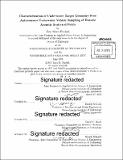Characterization of underwater target geometry from autonomous underwater vehicle sampling of bistatic acoustic scattered fields
Author(s)
Fischell, Erin Marie
DownloadFull printable version (16.61Mb)
Other Contributors
Woods Hole Oceanographic Institution.
Advisor
Henrik Schmidt.
Terms of use
Metadata
Show full item recordAbstract
One of the long term goals of Autonomous Underwater Vehicle (AUV) minehunting is to have multiple inexpensive AUVs in a harbor autonomously classify hazards. Existing acoustic methods for target classification using AUV-based sensing, such as sidescan and synthetic aperture sonar, require an expensive payload on each outfitted vehicle and expert image interpretation. This thesis proposes a vehicle payload and machine learning classification methodology using bistatic angle dependence of target scattering amplitudes between a fixed acoustic source and target for lower cost-per-vehicle sensing and onboard, fully autonomous classification. The contributions of this thesis include the collection of novel high-quality bistatic data sets around spherical and cylindrical targets in situ during the BayEx'14 and Massachusetts Bay 2014 scattering experiments and the development of a machine learning methodology for classifying target shape and estimating orientation using bistatic amplitude data collected by an AUV. To achieve the high quality, densely sampled 3D bistatic scattering data required by this research, vehicle broadside sampling behaviors and an acoustic payload with precision timed data acquisition were developed. Classification was successfully demonstrated for spherical versus cylindrical targets using bistatic scattered field data collected by the AUV Unicorn as a part of the BayEx'14 scattering experiment and compared to simulated scattering models. The same machine learning methodology was applied to the estimation of orientation of aspect-dependent targets, and was demonstrated by training a model on data from simulation then successfully estimating the orientations of a steel pipe in the Massachusetts Bay 2014 experiment. The final models produced from real and simulated data sets were used for classification and parameter estimation of simulated targets in real time in the LAMSS MOOS-IvP simulation environment.
Description
Thesis: Ph. D., Joint Program in Applied Ocean Science and Engineering (Massachusetts Institute of Technology, Department of Mechanical Engineering; and the Woods Hole Oceanographic Institution), 2015. Cataloged from PDF version of thesis. Includes bibliographical references (pages 153-156).
Date issued
2015Department
Joint Program in Applied Ocean Physics and Engineering; Woods Hole Oceanographic Institution; Massachusetts Institute of Technology. Department of Mechanical EngineeringPublisher
Massachusetts Institute of Technology
Keywords
Joint Program in Applied Ocean Science and Engineering., Mechanical Engineering., Woods Hole Oceanographic Institution.